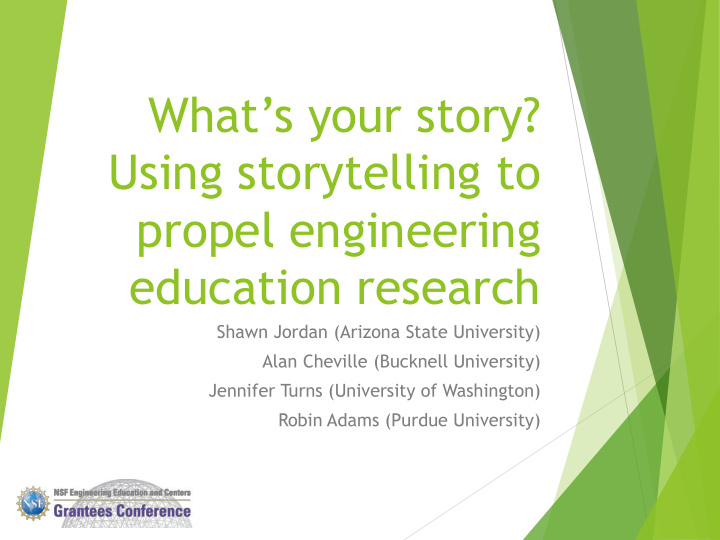



What’s your story? Using storytelling to propel engineering education research Shawn Jordan (Arizona State University) Alan Cheville (Bucknell University) Jennifer Turns (University of Washington) Robin Adams (Purdue University)
Workshop activities Doing storytelling Improving storytelling Appreciating storytelling
Doing storytelling Getting some material Think about a story related to some aspect of the research that brought you here (e.g., the origin story of the research, a success or challenge of the grant, anything…) Free write/draw for 3 minutes Sharing your story Find a partner Share your stories Time permitting, what did you like about each others’ stories Transition How can we get even better at storytelling – more intentional stories, more impactful stories, …
My Story
What was the difference between my bio (“what” story) you heard and the “why” story I just told you?
Messaging is a science. Best practices are research based. It is a skill. Practice it. Like teaching, it is also an art.
Why message? You wish to implement change. The power to create change lies with someone else.
“People don’t buy what you do, they buy why you do it.” – Simon Sinek
Theory of Change What do you want to change? Who has the power to change it? How does the action you will take create the change you want to see?
Using story to communicate your message Connect your Your personal story to one A specific ask story of the key messages
What is the personality of the big triangle? Heider-Simmel Illusion published 1944 “For sale, baby shoes, never worn.” 16
Stories serve an evolutionary purpose: • Cognitive play as a rehearsal for adult life. • Mental practice in a low-stakes environment for when the stakes are high. • Social glue. • Enforce moral and ethical behavior. Story allows us to make sense of fragmented experience. Filling in by narrative happens whether we will it or not - we create meaning. The quality of a story is judged by different metrics than the quality of a proof: • likeliness and alignment with past experience • situatedness and connection 17
Stories have an underlying structure in in Characters with specific Settings Action Intentions using particular Means Stories arise through tensions between these elements such as when means do not support actions or characters’ intentions do not align. 18 Bruner, J. (1987). Actual Minds, Possible Worlds . Cambridge, MA: Harvard University Press.
Story Structures
Story Structures: Hero’s Journey Return Departure Discovery Difficulty Campbell, J. (2008). The Hero with a Thousand Faces (Third Edition). Novato, CA: New World Library.
Story Structures: Simplified Basic story structure Beginning (set the context – the place, participants, time) Middle (describe the action – what happened, what problem is addressed, what changes occur) End (provide the resolution – growth achieved, wisdom gained, problem solved) Five Ps People, Place, Problem, Progress, Point http://vitalysthealth.org/wp-content/uploads/2018/08/Workbook-Storytelling.pdf
Story Structures: Simplified Inverted world Describe the normal world Trouble comes The world turns upside down Help comes or something is learned A new normal is established How something came to be How was it before? What changed? Could be over time or abruptly How is it now? What does it mean? http://vitalysthealth.org/wp-content/uploads/2018/08/Workbook-Storytelling.pdf
Which story structure resonates with you? How Something Hero’s Journey Inverted World Came to Be Characters in Action with specific Intentions in Settings using particular Means Basic Structure Five Ps: People, Place, Problem, Progress, Point
Choose one and explore using it to refine your story… How Something Hero’s Journey Inverted World Came to Be Characters in Action with specific Intentions in Settings using particular Means Basic Structure Five Ps: People, Place, Problem, Progress, Point
Appreciating storytelling Stories and storytelling are worthwhile and legitimate! Profoundly related to learning and identity formation Inspires and Builds empathy persuades, for bridging igniting and multiple shaping perspectives and transformative collaborative action sensemaking
Closing: 4+ word stories Channel your storytelling ability Take a minute, craft a 4+ word story Share!
Thank you!
Recommend
More recommend